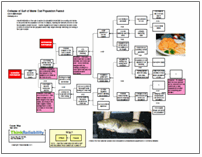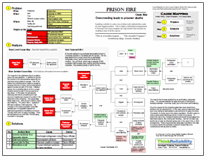How do you know when your solutions haven’t been effective? When the same problem keeps happening. Another prison fire claimed 360 lives in Honduras. This is the third fatal prison fire in nine years, resulting from chronic overcrowding and understaffing of Honduran jails.
Just more than 3 years since over 100 prisoners were killed in a prison fire in San Pedro Sula (see previous blog), 360 prisoners (so far) have died as a result of a fire in Comayagua Prison. (A fire in 2003 claimed the lives of 68 prisoners.) An open flame has been determined to be the cause of the fire but contributing to the deaths is that the prisoners were unable to get out.
 With any incident resulting in deaths of this magnitude, we can analyze the causes of the incident using a visual root cause analysis, or Cause Map. We begin with the impacts to the goals. In this case, the prisoner deaths were an impact to the safety goal. In addition, prison overcrowding can be considered an impact to the production goal, and a delay in rescue can be considered an impact to the customer service. Any damage resulting to the prison itself as a result of the fire is an impact to the property goal. Once we’ve determined the goals that were impacted, we can begin the analysis by asking “why” questions.
With any incident resulting in deaths of this magnitude, we can analyze the causes of the incident using a visual root cause analysis, or Cause Map. We begin with the impacts to the goals. In this case, the prisoner deaths were an impact to the safety goal. In addition, prison overcrowding can be considered an impact to the production goal, and a delay in rescue can be considered an impact to the customer service. Any damage resulting to the prison itself as a result of the fire is an impact to the property goal. Once we’ve determined the goals that were impacted, we can begin the analysis by asking “why” questions.
An investigation determined that an open flame (such as a cigarette or candle) and not arson, as was suggested prior to the investigation, caused the fire. However, severe overcrowding (more than 800 prisoners were in a jail with a capacity of 500) and a delay in the rescue of the prisoners contributed to the massive death toll.
Honduras has a chronic overcrowding problem. Honduras has a high rate of homicides and a high number of gang members. Gang members receive strict sentences and, in many cases, are jailed prior to conviction. However, an increased number of inmates has not led to an increased number of guards. On the night of the fire, there were 6 guards on duty. Guards who were in the towers were not allowed to leave their posts to help with the fire-fighting and rescue efforts. The guard who had the only set of keys fled prior to unlocking the doors. (The guards are facing disciplinary actions.) Firefighters were not allowed to enter the jail for 30 minutes after the fire call as the guards believed they were experiencing a riot or breakout. An inmate who was not in his cell at the time of the fire was able to free many prisoners.
This incident has added more fuel to the international outcry over the state of Honduras prisons. However, not much appears to have been done to improve conditions since the previous fires in 2003 and 2009, so it’s unclear if anything will change as a result of this fire. It is certainly apparent that the safety of prisoners cannot be maintained with the current overcrowding and number of guards. Additionally, procedures in the case of a fire certainly need to be improved to ensure that prisoners can be evacuated safely and securely.
To view the Outline and Cause Map, please click “Download PDF” above.



